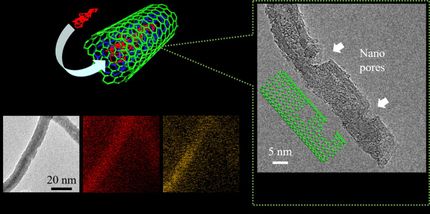A reconfigurable soft actuator
Transforming flat elastomers into 3D shapes
Mechanical systems, such as engines and motors, rely on two principal types of motions of stiff components: linear motion, which involves an object moving from one point to another in a straight line; and rotational motion, which involves an object rotating on an axis.

An initially flat thin circular sheet of elastomer with embedded electrodes morphs into a saddle shape
Image courtesy of the Clarke Lab/Harvard SEAS
Nature has developed far more sophisticated forms of movement -- or actuation--that can perform complex functions more directly and with soft components. For example, our eyes can change focal point by simply contracting soft muscles to change the shape of the cornea. In contrast, cameras focus by moving solid lenses along a line, either manually or by an autofocus.
But what if we could mimic shape changes and movements found in nature?
Now, researchers at the Harvard John A. Paulson School of Engineering and Applied Sciences (SEAS) have developed a method to change the shape of a flat sheet of elastomer, using actuation that is fast, reversible, controllable by an applied voltage, and reconfigurable to different shapes.
"We see this work as the first step in the development of a soft, shape shifting material that changes shape according to electrical control signals from a computer," said David Clarke, the Extended Tarr Family Professor of Materials at SEAS and senior author of the paper. "This is akin to the very first steps taken in the 1950's to create integrated circuits from silicon, replacing circuits made of discrete, individual components. Just as those integrated circuits were primitive compared to the capabilities of today's electronics, our devices have a simple but integrated three-dimensional architecture of electrical conductors and dielectrics, and demonstrate the elements of programmable reconfiguration, to create large and reversible shape changes."
The reconfigurable elastomer sheet is made up of multiple layers. Carbon nanotube-based electrodes of different shapes are incorporated between each layer. When a voltage is applied to these electrodes, a spatially varying electric field is created inside the elastomer sheet that produces uneven changes in the material geometry, allowing it to morph into a controllable three-dimensional shape.
Different sets of electrodes can be switched on independently, enabling different shapes based on which sets of electrodes are on and which ones are off.
"In addition to being reconfigurable and reversible, these shape-morphing actuations have a power density similar to that of natural muscles," said Ehsan Hajiesmaili, first author of the paper and graduate student at SEAS. "This functionality could transform the way that mechanical devices work. There are examples of current devices that could make use of more sophisticated deformations to function more efficiently, such as optical mirrors and lenses. More importantly, this actuation method opens the door to novel devices that deemed too complicated to pursue due to the complex deformations required, such as a shape-morphing airfoil."
In this research, the team also predicted the actuation shapes, given the design of the electrode arrangement and applied voltage. Next, the researchers aim to tackle the inverse problem: given a desired actuation shape, what is the design of the electrodes and the required voltage that will cause it?
Original publication
Other news from the department science
These products might interest you

Eclipse by Wyatt Technology
FFF-MALS system for separation and characterization of macromolecules and nanoparticles
The latest and most innovative FFF system designed for highest usability, robustness and data quality

Spinsolve Benchtop NMR by Magritek
Spinsolve Benchtop NMR
Spinsolve is a revolutionary multinuclear NMR spectrometer that provides the best performance

HYPERION II by Bruker
FT-IR and IR laser imaging (QCL) microscope for research and development
Analyze macroscopic samples with microscopic resolution (5 µm) in seconds

Get the chemical industry in your inbox
By submitting this form you agree that LUMITOS AG will send you the newsletter(s) selected above by email. Your data will not be passed on to third parties. Your data will be stored and processed in accordance with our data protection regulations. LUMITOS may contact you by email for the purpose of advertising or market and opinion surveys. You can revoke your consent at any time without giving reasons to LUMITOS AG, Ernst-Augustin-Str. 2, 12489 Berlin, Germany or by e-mail at revoke@lumitos.com with effect for the future. In addition, each email contains a link to unsubscribe from the corresponding newsletter.





























































